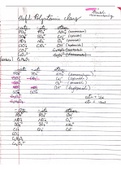CHE 106 (CHE106)
University Of Southern Mississippi
Popular textbooks

Chemistry 2e
Paul Flowers, Klaus Theopold, Richard Langley, Edward J. Neth, William R. Robinson
1 documents
All 10 results
Sort by
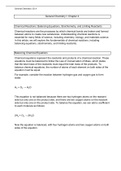
-
Chemical Reactions(Ch.4): balancing equations, stoichiometry, and limiting reactants
- Class notes • 5 pages • 2023
- Available in package deal
-
- $7.99
- + learn more
Chemical reactions are a fundamental aspect of chemistry, and they describe the transformation of one or more substances into new substances with different properties. Balancing chemical equations is an essential step in understanding and predicting chemical reactions, as it ensures that the same number and types of atoms are present on both sides of the equation. Stoichiometry is the quantitative relationship between the reactants and products in a chemical reaction, which can be used to determ...
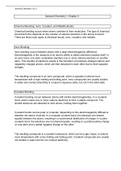
-
Chemical Bonding (Ch.3): ionic, covalent, and metallic bonds
- Class notes • 3 pages • 2023
- Available in package deal
-
- $7.99
- + learn more
Chemical bonding refers to the attractive forces that hold atoms together in a compound. There are three main types of chemical bonds: ionic, covalent, and metallic. Ionic bonding occurs when there is a transfer of electrons between atoms, resulting in the formation of ions that are held together by electrostatic forces. Covalent bonding occurs when atoms share electrons in order to complete their valence shells, resulting in the formation of a molecule. Metallic bonding occurs when there is a s...
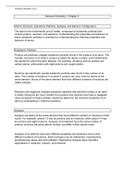
-
Atomic Structure (Ch.2): subatomic particles, isotopes, and electron configuration
- Class notes • 3 pages • 2023
- Available in package deal
-
- $7.99
- + learn more
Atomic Structure refers to the composition and arrangement of subatomic particles within an atom. The subatomic particles that make up an atom are protons, neutrons, and electrons. Protons and neutrons are found in the nucleus of the atom, while electrons are found in the electron shells or orbitals surrounding the nucleus. The number of protons in an atom determines the element that it represents, while the number of neutrons can vary within an element, resulting in isotopes. Isotopes are atoms...
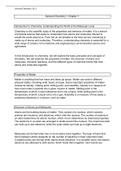
-
Introduction to Chemistry (Ch.1): Understanding the World at the Molecular Level
- Class notes • 3 pages • 2023
- Available in package deal
-
- $5.49
- + learn more
Introduction to Chemistry: matter, energy, and measurement is a fundamental course that provides an overview of the principles of chemistry. The course covers the study of matter and energy, including the properties and behavior of atoms, molecules, and chemical reactions. It also explores the different forms of energy and the ways in which energy is involved in chemical reactions and physical processes. The course emphasizes the importance of measurement in chemistry, including the metric syste...
Study guides and class notes for exams 1-4 (first through the final)

That summary you just bought made someone very happy. Also get paid weekly? Sell your study resources on Stuvia! Discover all about earning on Stuvia




